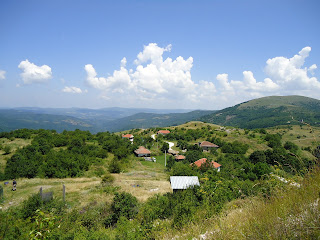Friday, 30 July 2010
Friday, 23 July 2010
Monday, 19 July 2010
Novo Brdo, Kosovo (week-end with Cris)
This past week-end, I went with Cristina, my Spanish roommate to Novo Brdo, in Kosovo, which lays around 70 kilometers from Vranje. Novo Brdo is the perfect place if you want to combine peaceful and gorgeous natural surrounding, pure air with historical richness.
We had the chance to find out on the internet a project of rural tourism existing for 3 years in this village supported by Care International. If this project didn't exist we would probably never get to this unreachable paradise on earth :-). We staid two days in an Albanian couple's house who offered "bed and breakfast" opportunity. Around 15 families currently welcome tourists who wish to enjoy for a couple of days the magnificent views this place provides.
For more information about this rural tourism project, you can check their well-done website at www.tourism-novobrdo.com


Written historical sources describe Novo Brdo as an antique fortified settlement of the Middle-Ages. It is mentioned as Nuovo Monte as early as 1326. Some scientists are of the opinion that this is where the antique city Damastion of the Dardan Kingdom lays. The areas rises to its economic and political culmination in the XIV and XV centuries with the development of the Novo Brdo mine rich in gold, lead and zinc minerals. Records show that in 1450, the Novo Brdo mine was producing about 6000 kg silver anually. In the begining of the XV century it rapidly developed into an important mining center rich in lead and silver and is considered to have been amongst the biggest settlement of the South-East Europe with about 50 000 inhabitants. Southern miners contributed to the development of the mining industry, whilst sale of goods bloomed thanks to the native Venetians, Hebrews and Ragosans in particular.
The medieval Novo Brdo comprised of the high city called the Citadel, the low Market-Place and the suburbs. The Citadel sat high above the city at the hill at 1124 meters above sea level. It comprised of strongly fortified surrounding walls and six oval towers positioned towards the South and the East. Archeological excavation from 1951 until 2003 have resulted in finding various architectural objects such as religious cults, dewlings as well as potteries and artifacts, gold and silver jewelery. Moreover, ceramical fragments and bronze coins have been found in Novo Brdo dating from the Bronze Age, Metal Age of the III and IV centuries A.D. All findings lead to conclusion that the city was built on the grounds of an antique temple of the IV century B.C stands out.
The riches of the then best known European mine were exploited by the current Empires of the time. Roman, Bizantine and Ottoman resulting in Novo Brdo's ruin and its weakening in the XVII century. The Austro-Ottoman war in 1689 was followed by massive migration of local population to Turkey, Macedonia, and other Kosovan cities of the time like Giljan, Prishtina, Prizren, Vucitrn and Mitrovica. Poor economy, political reactions, and long and cold winters are believed to have been the main contribution actors causing this movement.

Sunday, 18 July 2010
Subscribe to:
Posts (Atom)























































